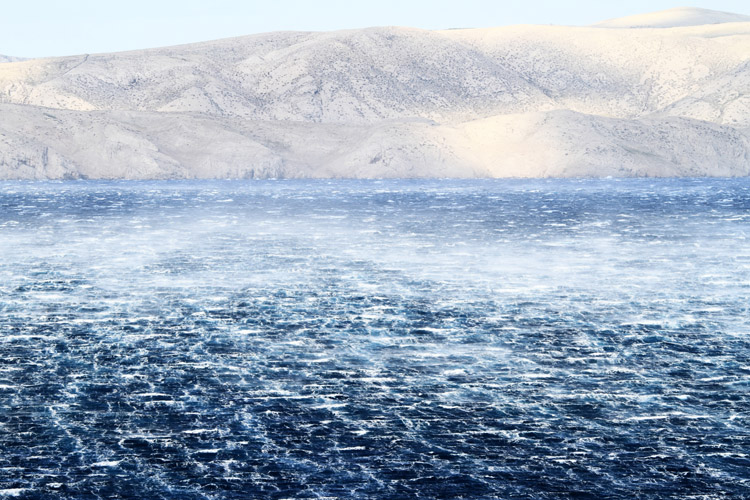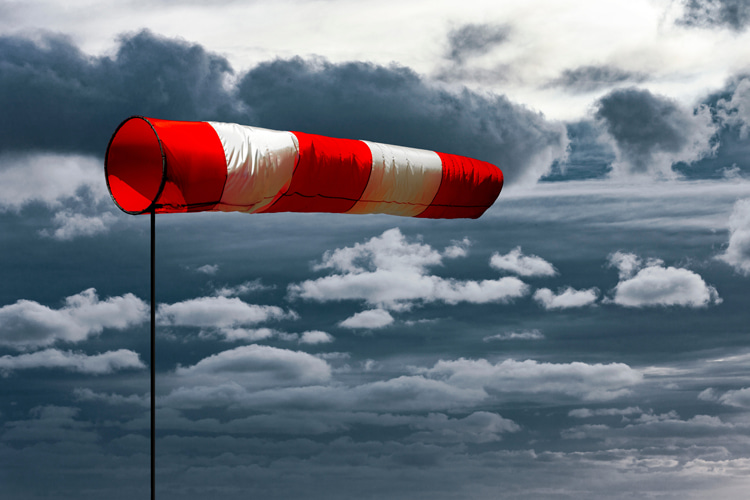The Beaufort Wind Force Scale was created in 1805 by Sir Francis Beaufort, an Irish-born Royal Navy Officer.
He developed an empirical wind speed model allowing everyone to assess the wind conditions on land and sea.
The wind table features intensity levels and their corresponding general weather description, wind speed, wave height, sea and land conditions, sea state photo, and associated warning flag.
The Beaufort Wind Force Scale is the best way of assessing, with your eyes only, the wind speed in a determined spot.
It is possible to measure the average wind force by observing the behavior of elements in the ocean and land.
Although it is not a 100 percent accurate tool, the Beaufort Wind Force Scale lets you know if, for example, you will be able to windsurf or sail away.

From Calm to Hurricane-Force Winds
The scale goes from "Calm" (Level 0) to "Hurricane Force" (Level 12).
The last stage of the Beaufort Wind Force Scale indicates you're experiencing more than 64 knots of wind.
From Level 6 on, there are warning flags associated with each step up in the wind speed category.
It's safe to say that you probably won't be windsurfing from Level 10 onward when storm warnings are issued.
The Beaufort Wind Force Scale is a paramount tool for amateur and recreational surfers, but it could also be useful to all sailors in general.
If you're riding in extreme wind conditions, the probability of damaging your sail is very high, and you will be putting your life at risk, too.
For accurate wind speed measurement, get a portable anemometer.
Last but not least, do you know what wind is and how it is formed?
| Beaufort Scale Number | Wind Speed (km/h) | Description | Wave Height (m) | Sea Conditions | Land Conditions |
|---|---|---|---|---|---|
| 0 | < 1 | Calm | 0 | Flat | Calm. Smoke rises vertically. |
| 1 | 1-5 | Light air | 0.1 | Ripples without crests | Wind motion visible in smoke. |
| 2 | 6-11 | Light breeze | 0.2 | Small wavelets. Crests of glassy appearance, not breaking. | Wind felt on exposed skin. Leaves rustle. |
| 3 | 12-19 | Gentle breeze | 0.6 | Large wavelets. Crests begin to break; scattered whitecaps. | Leaves and smaller twigs in constant motion. |
| 4 | 20-28 | Moderate breeze | 1 | Small waves | Dust and loose paper raised. Small branches begin to move. |
| 5 | 29-38 | Fresh breeze | 2 | Moderate (1.2 m) longer waves. Some foam and spray. | Branches of moderate size move. Small trees begin to sway. |
| 6 | 39-49 | Strong breeze | 3 | Large waves with foam crests and some spray. | Large branches in motion. Whistling is heard in overhead wires. Umbrella use becomes difficult. Empty plastic garbage cans tip over. |
| 7 | 50-61 | High wind, moderate gale, near gale | 4 | Sea heaps up, and foam begins to be blown in streaks in wind direction. | Whole trees in motion. Effort is needed to walk against the wind. The swaying of skyscrapers may be felt, especially by people on the upper floors. |
| 8 | 62-74 | Fresh gale | 5.5 | Moderately high waves with breaking crests forming spindrift. Streaks of foam. | Twigs broken from trees. Cars veer on the road. |
| 9 | 75-88 | Strong gale | 7 | High waves (6-7 m) with dense foam. Wave crests start to roll over. | Larger branches break off trees, and some small trees blow over. Construction/temporary signs and barricades blow over. Damage to circus tents and canopies. |
| 10 | 89-102 | Whole gale or storm | 9 | Very high waves. Large patches of foam from wave crests give the sea a white appearance. Considerable tumbling of waves with heavy impact. Large amounts of airborne spray reduce visibility. | Trees are broken off or uprooted, saplings bent and deformed, poorly attached asphalt shingles and shingles in poor condition peel off the roofs. |
| 11 | 103-117 | Violent storm | 11.5 | Exceptionally high waves. Very large patches of foam, driven before the wind, cover much of the surface. Very large amounts of airborne spray severely reduce visibility. | Widespread vegetation damage. More damage to most roofing surfaces. Asphalt tiles that have curled up and/or fractured due to age may break completely. |
| 12 | > 118 | Hurricane force | > 14 | Huge waves. The sea is completely white with foam and spray. Air is filled with driving spray, greatly reducing visibility. | Considerable and widespread damage to vegetation, a few windows broken, structural damage to mobile homes, and poorly constructed sheds and barns. Debris may be hurled about. |
